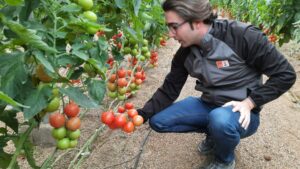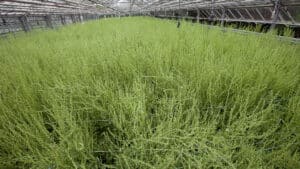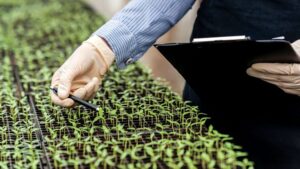Organizations and associations look forward to a vastly different approach when it comes to how plant breeding innovations are regulated, but as the old saying goes, “the devil is in the details.”
In early June, the U.S. Department of Agriculture (USDA) released its proposed rule regarding the movement and release of genetically engineered (GE) organisms as it relates to gene editing and plant breeding innovation. This was followed by an Executive Order on Modernizing the Regulatory Framework for Agricultural Biotechnology from President Trump.
The rules, originally established in 1987, haven’t been updated since. The USDA’s Animal and Plant Health Inspection Service (APHIS) released proposals in 2008 and again in 2017, both of which were withdrawn due to concerns submitted during the comment period. If completed, this would mark the first comprehensive revision of the regulation in nearly four decades — a great deal has changed since then.
Through the new regulation, USDA aims to provide a “clear, predictable and efficient regulatory pathway for innovators, facilitating the development of new and novel genetically engineered organisms that are unlikely to pose plant pest risks.”
The proposed framework is a different approach altogether. According to the docket (APHIS-2018-0034), “the regulatory efforts would focus on the properties of the GE organism itself rather than on the method used to produce it.”
With this approach, Secretary of Agriculture Sonny Perdue says USDA seeks to allow innovation when there is no risk present.
Need to Know
Under the proposed rule, developers would have the option of requesting a permit or a regulatory status review of a GE plant that has not been previously reviewed and determined to be nonregulated. Decisions on regulatory status would be based on APHIS’ assessment of pest risk.
Additionally, certain categories of modified plants would be exempted from the regulations in part 340, because they could be produced through traditional breeding techniques and are unlikely to pose a greater plant pest risk than traditionally bred crops, which APHIS has historically regulated.
Furthermore, the proposed rule would exempt GE plants with plant-trait-mechanism of action (MOA) combinations that APHIS has already evaluated by conducting a regulatory status review and found to be unlikely to pose a plant pest risk.
Under the proposed rule, developers would have the option to make a self-determination as to whether his or her GE plant belongs to one of the categories listed under 340.1(b) or (c) and is exempt from the regulations. Developers who determine their plant is exempt also have the option to request written confirmation from APHIS that the self-determination is valid, which could be beneficial and use to further international trade.
For those GE plants that must undergo a regulatory status review, APHIS will in combination and individually evaluate the plant pest risk based on three elements:
- The basic biology of the plant prior to modification.
- The trait that resulted from the genetic modification.
- The plant-trait-mechanism of action.
The public had until Aug. 5 to submit comments for consideration in the final rule. Organizations from the American Seed Trade Association (ASTA) to the National Sunflower Association, and from the Agricultural Retailers Association to the U.S. Apple Association submitted comments and letters of support, representing their constituents.
ASTA’s Andy LaVigne, president and CEO, says: “We commend USDA for working to update its long-standing regulatory system for genetically engineered organisms to ensure it keeps pace with the latest scientific advancements … and for using its long experience in regulating these organisms as a basis for making improvements.”
The association appreciates that USDA’s proposal recognizes that some applications of gene editing result in plant varieties that are essentially equivalent to varieties developed through more traditional breeding methods and treats these varieties accordingly.
However, in its letter to the Alan Pearson, APHIS Biotechnology Regulatory Services assistant deputy administrator, ASTA recommends changes to definitions, structure and the language regarding exemptions.
Little Details, Big Impact
Specifically, ASTA recommended defining “genetically engineered organism” as: “An organism developed using genetic engineering, excluding those offspring that do not retain the genetic modification of the parent. For the purposes of this part, a plant will not be considered a genetically engineered organism if it meets any of the criteria outlined in 340.1(b)(1)-(3) …”
Concerned that “genetic engineering” is often used synonymously with terms such as “biotechnology,” “modern biotechnology,” and “genetic modification,” ASTA believes its recommendation would provide clarity that not all plants derived from the broad definition of “genetic engineering” in the proposal would automatically be regulated.
When it comes to the proposed exemptions, LaVigne explained that significant applications of genome editing with results that could be achieved through traditional breeding, such as spontaneous and induced mutagenesis, would still need to go through the new Regulatory Status Review process. ASTA recommended that the scope of exemptions should reflect the range of genetic changes that occur in a plant through the breeding process.
ASTA also pointed out that if the proposed rule went into effect, it would be inconsistent and more restrictive than policies in Argentina and Chile.
In the letter, LaVigne added that USDA should not restrict the scope of exemptions to what is technically achievable today.
“The improvement of technology is a continuous process,” he wrote. “We recommend that the Agency provide a mechanism in the final rule for reviewing the existing exemptions and adding additional ones through an expedited process as development occur.
ASTA also recommended adding details and clarity to the confirmation process.
“There is a real risk that the confirmation process would become a de facto mandatory process without any assurances to the developer of how the process will, in fact, work,” LaVigne noted. “USDA has not laid out any specifics with respect to information needed or timelines if a developer chooses to use this option.”
The recommendations outlined above show the work and benefit of ASTA, as well as the advancements in plant breeding. It’s clear more work is needed but in general agricultural groups support the direction and movement.
Dana O’Brien, BIO’s food and agriculture section executive vice president, says: “BIO appreciates USDA’s diligent approach in undertaking this important biotechnology rulemaking and the agency’s overall commitment to improving predictability and pre-market oversight based on actual risk.”
The Agricultural Retailers Association hopes that the final rule will encourage other countries to adopt GE plant varieties so that farmers across the globe can achieve the sustainability and yield benefits that American agriculture has since the adoption of GE crops.
USDA is one of three federal agencies that regulate products derived from food and agricultural technology. Together, USDA, the Environmental Protection Agency and the Food and Drug Administration have a Coordinated Framework for the Regulation of Biotechnology that ensures these products are safe for the environment and human health. USDA’s regulations focus on protecting plant health, while FDA oversees feed and food safety and EPA regulates the sale, distribution and testing of pesticides to protect human health and the environment.
“Today, as we face unprecedented global-scale challenges like climate change, emerging pests and diseases and rapid population growth, plant breeding continues to evolve and innovate, to help deliver critical solutions, through methods like gene editing that are more precise and efficient than ever before,” Secretary Perdue says. “Plant breeding innovation holds enormous promise for helping protecting crops against drought and diseases while increasing nutritional value and eliminating allergens.
“Using this science, farmers can continue to meet consumer expectations for healthful, affordable food produced in a manner that consumes fewer natural resources. This new innovation will help farmers do what we aspire to do at USDA: do right and feed everyone.”













